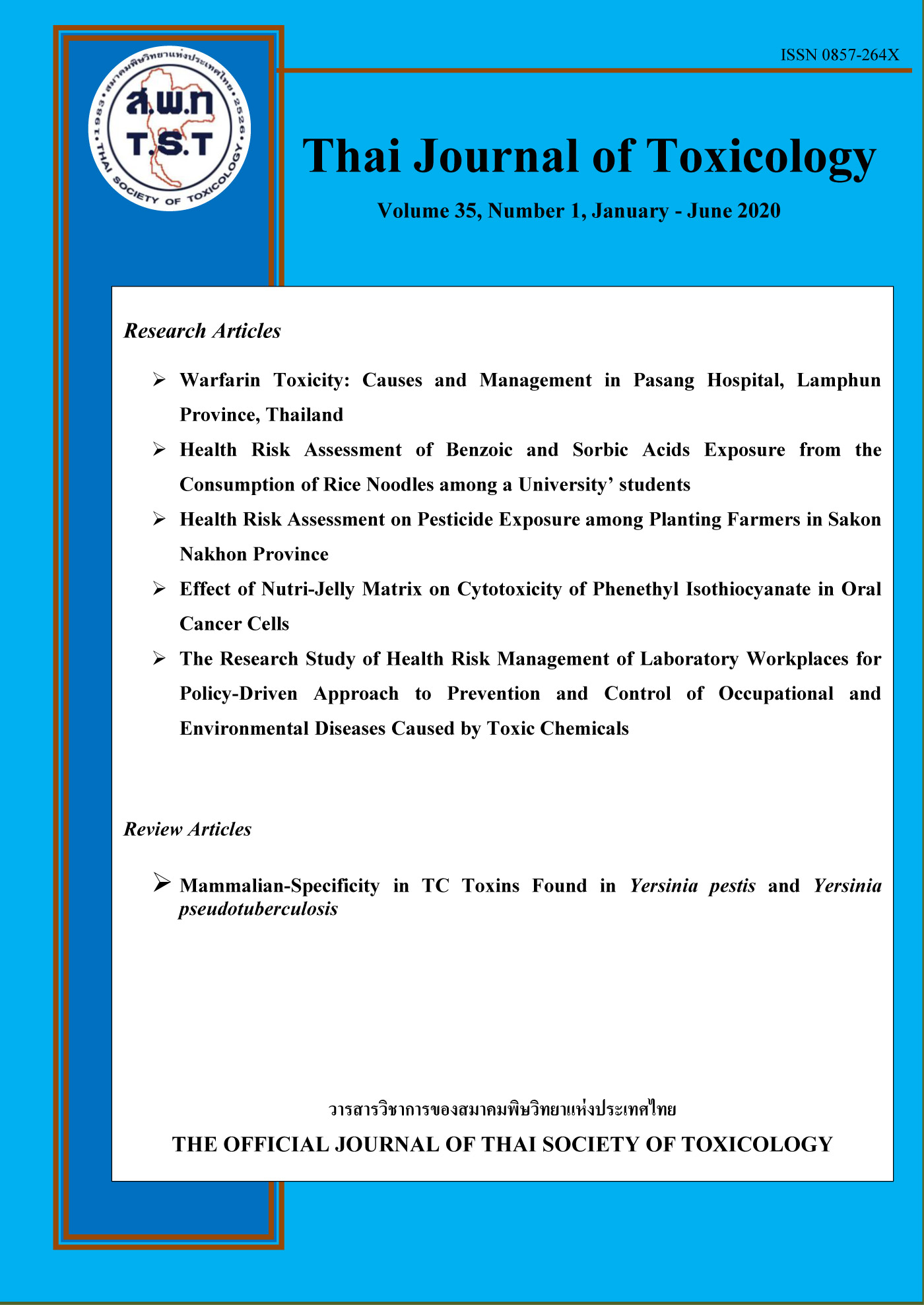การประเมินความเสี่ยงต่อสุขภาพของการได้รับสัมผัสกรดเบนโซอิกและกรดซอร์บิกจากการบริโภคก๋วยเตี๋ยวในนักศึกษามหาวิทยาลัย
Main Article Content
บทคัดย่อ
การศึกษานี้มีวัตถุประสงค์ เพื่อวิเคราะห์ปริมาณกรดเบนโซอิกและกรดซอร์บิกในเส้นก๋วยเตี๋ยว 3 ชนิด ได้แก่ ก๋วยเตี๋ยวเส้นใหญ่ เส้นเล็ก และเส้นหมี่ จำนวน 30 ตัวอย่าง จาก 10 ร้านที่จำหน่ายในมหาวิทยาลัยวลัยลักษณ์ วิเคราะห์โดยเทคนิค High Performance Liquid Chromatography (HPLC) และประเมินความเสี่ยงต่อสุขภาพของนักศึกษาจากปริมาณการรับสัมผัส เทียบกับค่าระดับความปลอดภัยที่ร่างกายสามารถรับได้ต่อวัน (Acceptable Daily Intake: ADI) ผลการวิเคราะห์พบกรดเบนโซอิกจำนวน 27 ตัวอย่าง (ร้อยละ 90) มีปริมาณ 0.85-666.90 มิลลิกรัมต่อกิโลกรัม ในขณะที่ตรวจพบกรดซอร์บิกจำนวน 13 ตัวอย่าง (ร้อยละ 43.33) มีปริมาณ 0.5-359.43 มิลลิกรัมต่อกิโลกรัม พบปริมาณกรดเบนโซอิกเฉลี่ยสูงสุดในตัวอย่างก๋วยเตี๋ยวเส้นใหญ่ (ค่าเฉลี่ย = 234.65±111.07 และค่ามัธยฐาน = 269.52) และพบปริมาณกรดซอร์บิกเฉลี่ยสูงสุดในตัวอย่างก๋วยเตี๋ยวเส้นเล็ก (ค่าเฉลี่ย = 107.20±124.76 และค่ามัธยฐาน = 62.8) ปริมาณที่ตรวจพบทั้งหมดไม่เกินเกณฑ์มาตรฐานของกระทรวงสาธารณสุข ผลการประเมินความเสี่ยงต่อสุขภาพของนักศึกษากรณี Worst-case scenarios ซึ่งใช้ข้อมูลความถี่และปริมาณสูงสุดในการบริโภคสำหรับการคำนวณ มีค่าความเสี่ยงเฉลี่ยและค่าความเสี่ยงระดับสูงในระดับที่ก่อให้เกิดอันตรายต่อสุขภาพ โดยมีค่าความเสี่ยงสูงสุดกรณีความเสี่ยงระดับสูงของการรับสัมผัสกรดเบนโซอิกและกรดซอร์บิกเท่ากับร้อยละ 981.30 และ 195.02 ของค่า ADI ตามลำดับ ซึ่งสามารถลดความเสี่ยงต่อสุขภาพด้วยการลดปริมาณการบริโภคลงเป็นบริโภคไม่เกิน 1 ชามต่อวัน
Article Details
เอกสารอ้างอิง
สถาบันวิจัยระบบสาธารณสุข. รายงานการสำรวจการบริโภคอาหารของประชาชนไทย, 2552. Available at https://www.hiso.or.th/ hiso5/report/report6.php, accessed July 30, 2019.
อินทิรา แก้วมาตร, สุวลี โล่วิรกรณ์. ภาวะโภชนาการ พฤติกรรมการบริโภคอาหาร และพฤติกรรมสุขภาพของนักศึกษาสาขาอาหารและโภชนาการ วิทยาลัยอาชีวศึกษาขอนแก่น. วารสารวิจัยสาธารณสุขศาสตร์ มหาวิทยาลัยขอนแก่น 2553; 3(2): 29-36.
ศรัลยภัคร์ ชำนาญ. ผลของเวลา วัตถุกันเสีย และอุณหภูมิการเตรียมน้ำแป้งที่มีต่อคุณภาพการผลิตเส้นก๋วยเตี๋ยวสด. วิทยานิพนธ์วิทยาศาสตรมหาบัณฑิต สาขาวิชาเทคโนโลยีทางอาหาร มหาวิทยาลัยแม่โจ้ 2551.
สำนักงานคณะกรรมการอาหารและยา. ประกาศกระทรวงสาธารณสุข เลขที่ 389 พ.ศ.2561 เรื่อง วัตถุเจือปนอาหาร (ฉบับที่ 5), 2561. Available at http://www.fda.moph.go.th/sites/food/FoodAdditives/P389.pdf, accessed July 30, 2019.
WHO. Concise International Chemical Assessment Document 26: BENZOIC ACID AND SODIUM BENZOATE, 2000. Available at https://www.who.int/ipcs/publications/cicad/cicad26_rev_1.pdf, accessed July 29, 2019.
FAO/ WHO. Evaluations of the Joint FAO/ WHO Committee on Food Additives (JECFA): BENZYL BENZOATE, 2019. Available at http://apps.who.int/food-additives-contaminants-jecfa-database/chemical.aspx?chemID=4874, accessed July 29, 2019.
Walker R. Toxicology of sorbic acid and sorbates. Food Addit Contam 1990; 7(6): 671-6.
Silva MM, Lidon FC. Food preservatives-An overview on applications and side effects. Emir J Food Agri 2016; 28(6): 366-73.
FAO/ WHO. Evaluations of the Joint FAO/ WHO Committee on Food Additives (JECFA): SORBIC ACID, 2019. Available at http://apps.who.int/food-additives-contaminants-jecfa-database/chemical .aspx ?chemID=2443, accessed July 29, 2019.
เสกสรร ทองโพธิ์, วีระพร แจ่มศรี, ยุพเรศ เอื้อตรงจิตต์ และคณะ. คุณภาพอาหารประเภทเส้นที่จำหน่ายในเขตกรุงเทพและปริมณฑลระหว่างปี 2555-2559, 2560. Available at http://e-library.dmsc.moph.go .th/ebooks/files/P2-40%20ทองโพธิ์.pdf, accessed July 29, 2019.
พชรมน ทาชุลี, น้อย ทองสกุลพานิชย์. วัตถุกันเสียในผลิตภัณฑ์เส้นก๋วยเตี๋ยว, 2557. Available at http://www.dmsc.moph.go.th/khonkaen07/upload/knowledge/k57_33.pdf, accessed July 29, 2019.
เสาวภา ชูมณี. การพัฒนาวิธีการวิเคราะห์หาปริมาณสารกันเสีย (กรดเบนโซอิก กรดซอร์บิค เมทิลพาราเบน และโพรพิลพาราเบน) ในอาหารและเครื่องสำอาง โดยเทคนิคโครมาโทกราฟีของเหลวแบบสมรรถนะสูง. รายงานวิจัย 2552.
AOAC. Officail Method of Analysis, 16th edition. Washington DC: AOAC, 2000.
ธานินทร์ ศิลป์จารุ. การวิจัยและวิเคราะห์ข้อมูลทางสถิติด้วย SPSS. กรุงเทพฯ: วี. อินเตอร์ พริ้นท์, 2553.
FAO/ WHO. Dietary Exposure Assessment of Chemicals in Food. Report of a Joint FAO/WHO Consultation. Geneva: WHO, 2008.
ศิรินทิพย์ อินทร์ชัย, สมชาย สิทธิโอภากุล. ปริมาณกรดเบนโซอิคและกรดซอร์บิคในก๋วยเตี๋ยวในเขตเทศบาลนครราชสีมา. วารสารวิชาการสาธารณสุข 2551; 17(5): 744-50.
สถาบันอาหาร. สารกันบูดในเส้นใหญ่, 2555. Available at http://fic.nfi.or.th/ foodsafety/upload/comefood/pdf/Nfitr_649.pdf, accessed July 31, 2019.
พรทิพย์ ผลประเสริฐ, ศศิวีณ์ นรากร, อดิศร เสวตวิวัฒน์. การตรวจเฝ้าระวังน้ำพริกแบบแห้งพร้อมบริโภคที่จำหน่ายในเขตกรุงเทพมหานคร. วารสารอาหารและยา 2559; 23(1): 21-7.
กิตติมา โสนะมิตร์, วันทนีย์ ขำเลิศ. ปริมาณโซเดียมเบนโซเอต และสีอินทรีย์สังเคราะห์ในอาหาร. วารสารกรมวิทยาศาสตร์การ แพทย์ 2552; 51(2): 170-5.
ยศยา ทุริสุทธิ์, อรรณพ ทัศนอุดม, ลัดดา วัฒนศิริธรรม และคณะ. การต้านทานกรดเบนโซอิกของ Aspergillus flavus ในน้ำพริกตาแดง. วารสารวิทยาศาสตร์ มหาวิทยาลัยขอน แก่น 2559;44(1): 111-23.
เวณิกา เบ็ญจพงษ์, จักรกฤษณ์ สกลกิจติณภากุล, อาณดี นิติธรรมยง และคณะ. การประเมินการได้รับสัมผัสกรดเบนโซอิกจากการบริโภคเนื้อสัตว์และสัตว์น้ำแปรรูป ขนมอบและเครื่องดื่มในผลิตภัณฑ์กลุ่มเสี่ยงที่ประชากรไทยนิยมบริโภค. วารสารพิษวิทยาไทย 2556; 28(2): 1-16.
ปวีณ์ดา ศรีพนารัตนกุล, เวณิกา เบ็ญจพงษ์, ปิยนุช วิเศษชาติ และคณะ. การประเมินความเสี่ยงต่อการได้รับสัมผัสกรดเบนโซอิกและกรดซอร์บิกจากการบริโภคอาหารประเภทไส้กรอกและหมูยอของคนไทย. วารสารพิษวิทยาไทย 2552;24(1): 27-36.
พัจนภา วงศาพรหม, เวณิกา เบ็ญจพงษ์, วีรยา การพานิช และคณะ. การประเมินความเสี่ยงต่อการได้รับสัมผัสกรดเบนโซอิกและกรดซอร์บิกจากการบริโภคเครื่องแกงเผ็ดในเขตกรุงเทพมหานครและสุพรรณบุรี. วารสารพิษวิทยาไทย 2552; 24(1): 17-26.
พัชริดา พิชัย, นฤมล ขันตีกุล. การประเมินการได้รับสัมผัสของกรดเบนโซอิกในน้ำพริกหนุ่มที่จำหน่ายในจังหวัดเชียงใหม่ ปี พ.ศ.2553-2556. วารสารกรมวิทยาศาสตร์การแพทย์ 2558; 2: 198-207.
สุวรรณี ธีรภาพธรรมกุล, ลัดดาวรรณ โรจนพรรณทิพย์, พนาวัลย์ กลึงกลางดอน และคณะ. การประเมินความเสี่ยงของกรดเบนโซอิคและกรดซอร์บิคในอาหารต่อคนไทย. วารสารวิชาการสาธารณสุข 2559; 25(1): 49-59.


